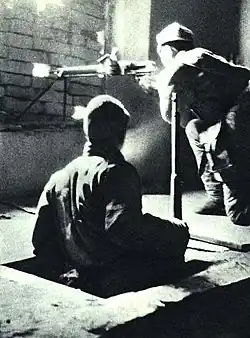Central Hebei tunnel warfare

The Central Hebei tunnel warfare (Chinese: 冀中地道战) was a unique guerilla strategy devised by the Chinese military and people on the North China Plain from 1941 to 1945, during the War of Resistance Against Japanese Aggression. The central focus of this plan was situated in Baoding, Li County, and Qingyuan within Hebei Province.[1]
History
In the autumn of 1941, confronted with the Japanese army's "Three Alls Policy" and fortified blockades, local inhabitants originally excavated single-entrance concealment pits—termed "toad squats"—for shelter; however, these were readily obliterated due to their rudimentary design. Following the extensive Japanese "May 1st Sweep" in 1942, the Central Hebei Committee of the Chinese Communist Party and the military region advanced the development of tunnel building.[2] These developed into dual- and multi-entrance edifices, progressively establishing a vast subterranean network that linked residences and even villages, with an aggregate length surpassing 12,000 kilometers.[3]
The tunnels at Ranzhuang Village, Qingyuan County, exemplify a notable case. The network comprised four primary lines and 24 branches, extending around 16 kilometers in total. It included observation apertures, fire ports, traps, poison-resistant trapdoors, grain storage compartments, and a waterproofing system connected to wells.[4] Militia forces employed tunnels alongside landmines and guerrilla tactics, establishing a three-dimensional defense system through "three connections" (houses, tunnels, and bunkers) and "three interlocks" (open and concealed firepower, high and low firepower, and crossfire between streets and bunkers).[5] From 1942 to 1945, Ranzhuang's militia conducted 157 actions and provided support to main forces on 85 occasions. In a significant occurrence, they eliminated or injured 33 Japanese soldiers while sustaining only one minor injury among their defenders.[6]
Marshal Nie Rongzhen lauded tunnel warfare as “a significant innovation in overcoming adversaries on the plains.”[7] The Historic Site of Ranzhuang tunnel war was named a Major Historical and Cultural Site Protected at the National Level in 1961.[8]
See also
References
- ^ 董耀奎 (2015-01-01). 保定抗戰史話 (in Chinese). 新華出版社. p. 416. ISBN 978-7-5166-1881-3. Retrieved 2025-07-11.
- ^ 可愛的河北 (in Chinese). 河北人民出版社. 1984. p. 322. Retrieved 2025-07-11.
- ^ 编著, 徐泽荣 (2023-11-01). 国共抗战收复失地比较: ---跟国粉认知相反的共方抗战业绩 (in Chinese). Bouden House. p. 134. ISBN 979-8-210-74690-0. Retrieved 2025-07-11.
- ^ 肖风 (史志) (2003). 河北省志: 建筑业志. 第36卷 (in Chinese). 河北人民出版社. p. 368. ISBN 978-7-202-03554-2. Retrieved 2025-07-11.
- ^ 星火燎原 (in Chinese). 解放军出版社. 1900. p. 351. ISBN 978-7-5065-0087-6. Retrieved 2025-07-11.
{{cite book}}: ISBN / Date incompatibility (help) - ^ 武菁; 郭红娟 (2008). 抗日战争纪事本末: 1931-1945 (in Chinese). 安徽大学出版社. p. 146. ISBN 978-7-81110-427-1. Retrieved 2025-07-11.
- ^ 爱国主义教育示范基地大博览 (in Chinese). 红旗出版社. 1998. p. 97. ISBN 978-7-5051-0138-8. Retrieved 2025-07-11.
- ^ 抗战档案 (in Chinese). 中央文献出版社. 2005. p. 722. ISBN 978-7-5073-1907-1. Retrieved 2025-07-11.